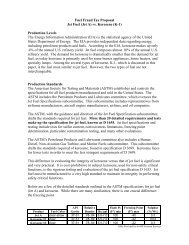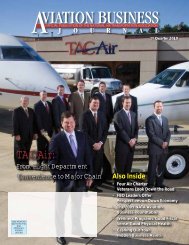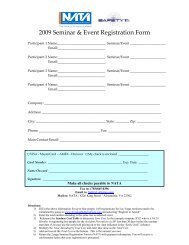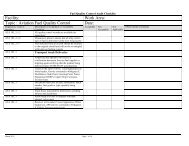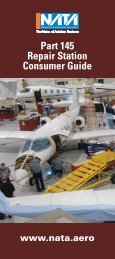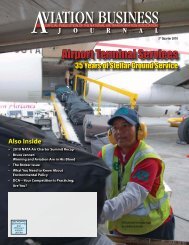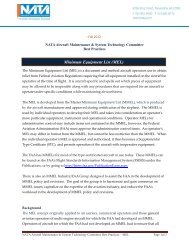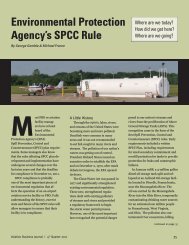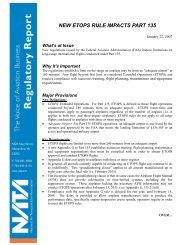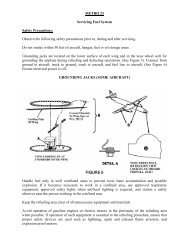Computer-Based Maintenance Tracking Flight Training ... - NATA
Computer-Based Maintenance Tracking Flight Training ... - NATA
Computer-Based Maintenance Tracking Flight Training ... - NATA
- No tags were found...
Create successful ePaper yourself
Turn your PDF publications into a flip-book with our unique Google optimized e-Paper software.
<strong>Computer</strong>-<strong>Based</strong> <strong>Maintenance</strong> <strong>Tracking</strong>Continued from page 46coming along and could impactthe value of their aircraft. That’swhere OEM systems will have anadvantage over the technologytypeproducts.”But just as there are choices ofplans and formats, it is also generallyagreed that the maintenancetracking systems will furtherevolve based on user expectations,which are already beingexpressed.“There are some operators whohave requested a ‘Swiss armyknife’ approach to computerizedmaintenance tracking,” ATP’s BobJones said. “They want a totallyintegrated tool that will not onlytrack maintenance but includetechnician management, billing,and other back-office functions,including inventory control andshop workflow. In the past, it hasbeen very hard to find a tool thatdoes all of this well, but we realizethat this is probably going to bethe next generation of maintenancetracking software.”Bill Mayo, chief executive officerof Mayo Aviation, an aircraftmanagement, charter, and repairstation operator at Denver-CentennialAirport, agrees. “The capabilityto integrate across platforms,such as software designed to trackscheduling and flight activity, isvery important,” he said. “At MayoAviation, we have a separate softwareproduct that tracks schedulingand flight activity. But there isalso an interface that permits ourAvtrak (maintenance tracking)software to work with this productin order to update the flight activityof all the aircraft we operate.It only takes one person to updatethis information.”At the same time, Mayo wouldlike maintenance tracking systemsto cut across more platforms andareas of data. “I’d like to see all ofthe information, coming from themaintenance activities at the hangarentered into a computer, andautomatically updated with a minimumnumber of touch points,” hesaid. “It would be a matter of puttingin the data, which would thenbe sent to where it needs to go,including the individual aircraft’slog books, and the service center’sother record-keeping departments,such as inventory control andparts shipping and receiving. Thetechnology is getting to a pointwhere we’ll be able to have a moreintegrated, enterprise-wide product.”<strong>Based</strong> on his customers’ reports,there are two main issues concerningthe future of computerizedaircraft maintenance trackingproducts, said Victor Josephson,director of technical solutions forCAMP Systems in Ronkonkoma,N.Y. CAMP is considered theoldest vendor of computer-basedmaintenance for business aircraft.“Some, frankly, want less complicatedand easier-to-use systems.Others would like to see thesystems become more complex,expanding to include inventorymanagement and flight schedulingintegration,” Josephson said.“But the big issue today is theamount of paperwork that still hasto be filled out by hand and signedoff on.”He reported that CAMP Systemssends out approximately 5,300sets of paper reports each monthto its subscribers. “You hear a lotof talk about going to the paperlesshangar, but I don’t know ifwe’ll ever get to that point. It’s stilla paper-based culture.”Still, Bristol Associates’ SeanLancaster predicted that digitizationwill continue to expand aswell as evolve. “Within the nextfive to ten years, maintenancedepartments will be able to scanthe serial numbers on all the partsand components in the airplaneusing a hand-held device, whichwill then download the data intothe maintenance computer,” hesaid. “This will eliminate anymistakes made by copying the informationby hand, eliminate thetime involved in looking up paperrecords, and automatically updatethe records on the part.”But Lancaster cautioned that theFAA still requires paper recordsto be made available for all tasksdone on the aircraft, along with anauthorized signature.“Aircraft maintenance recordsare normally derived from foursources: the aircraft’s own logbooks,the APU (if it has one),each engine’s logbook, and workscope cards. Most of that is still onpaper. For security purposes, weare seeing a trend toward puttingall that in digital form, using scanners,and then storing that informationoff site.”What’s Out ThereWhile it is not intended to be acomplete list of all maintenancetracking systems available forbusiness aircraft, Aviation BusinessJournal has identified seven vendorsthat are considered the majorplayers in this field. In addition toproviding a general description oftheir products, we have includedany new developments that thevendors have made public as ofAugust 1.AircraftTechnical Publishers<strong>Maintenance</strong> Director Planner<strong>Maintenance</strong> Director E-LOG<strong>Maintenance</strong> Director EnterpriseATP has three products designedfor maintenance tracking within alocal area network (LAN) or singlePC, windows-based environment.Each product caters to any aircraftapplication, including business,commercial, and even militarymodels.<strong>Maintenance</strong> Director E-LOG,introduced in 1998, is a compre-48 Aviation Business Journal | 3 rd Quarter 2007


